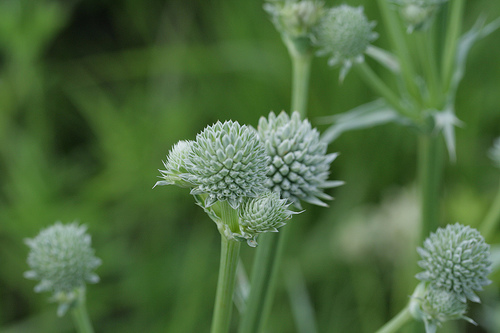Prairie Plants for Heavy Clay Soil

Prairie Restoration Basics
- Tallgrass Prairie Restoration
An introductory guide to planning, creating, and maintaining a prairie garden or restoration project of your own.
Most native prairie plants prefer well-drained, or even dry, soils. However, if you are interested in a native prairie border or restoration project on your land and are stuck with heavy clay or poorly drained soil, don't despair! There are many beautiful prairie plants that tolerate and even thrive in heavy clay. These clay-busting plants can even improve your soil's drainage and soil structure.
Prairie plants have extraordinary root structures. The compass plant, one of the tallest of native wildflowers at 6-8 feet, has roots that stretch twice as deep into the ground. When you take into account the thousands upon thousands of tiny rootlets, if you laid every piece of root from a single compassplant end to end, they would encircle the earth.
These incredible prairie root systems help clay soil in many ways. As they grow, they plow through the soil, breaking up clods and hardpan. Throughout their lives, they pull nutrients from deep in the soil closer to the surface where plantscan use them. And when they die, they rot in the soil, providing organic matter and food for earthworms and other decomposers. The empty space left by the decomposed rootlet allows air and water to flow more easily through the soil, improving drainage and soil structure.
It is no coincidence that the land once covered by tallgrass prairie is the breadbasket of the world.



Native Wildflowers for Heavy Clay
- Bergamot, a unique flower that is popular with butterflies and hummingbirds
- Black-eyed Susan, an extremely popular and easy-to-grow native wildflower
- Compassplant, a tall wildflower with lots of small, yellow daisy-like flowers, very popular with birds and butterflies
- Lanceleaf Coreopsis, lots of cheery yellow flowers
- New England Aster, masses and masses of small, daisy-like flowers, very popular with birds and butterflies
- Pale Purple Coneflower, attractive flowers and seedheads, very popular with birds and butterflies
- Partridge Pea, a nitrogen-fixing legume with cheery yellow flowers
- Prairie Blazing Star, highly ornamental
- Prairie Dock, small, yellow daisy-like flowers, popular with birds and butterflies
- Purple Coneflower, attractive flowers and seedheads with medicinal value for humans, very popular with birds and butterflies
- Purple Prairie Clover, a nitrogen-fixing legume
- Rattlesnake Master, unique and interesting flowers
- White False Indigo, masses of showy white blooms
- Yellow Coneflower, cheery yellow blooms

Native Prairie Grasses for Heavy Clay
- Big Bluestem, the king of the tallgrasses, an attractive blueish-green grass that turns red-bronze in autumn and has a characteristic "turkey foot" seedhead
- Canada Wild Rye, attractive seedheads resembling cultivated rye
- Indiangrass, beautiful golden seedheads
- Switchgrass, lacy seedheads and attractive blue-green coloring in summer, gold in winter
Seed Mixes for Heavy Clay
A number of nurseries offer special seed mixes for heavy clay soils, including:
Prairie Nursery offers its popular "Clay Buster Mix," as well as special mixes for detention basins, rain gardens,and moist meadows.
Prairie Moon Nursery offers mixes especially for exposed clay subsoil, marshy and poorly drained soils, and detention basins.
Ion Exchange offers a number of mixes prepared for various wet and clay soil types.








